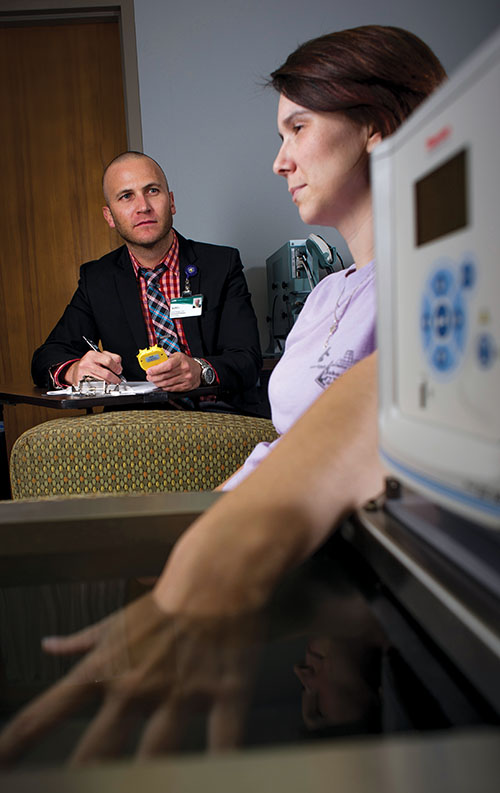Burel R. Goodin, Ph.D., traces his interest in pain back to his days as an outside linebacker for the Illinois College Blueboys. Early in one game, a fellow linebacker hurt his arm in a tackle, but he shook off the sting and stayed on the field. It wasn’t until after the final whistle blew that the injured teammate discovered he had a compound fracture in his arm.
“One of the bones in my friend’s forearm was broken, but he finished the whole game before getting any pain meds or medical attention,” says Goodin, a clinical health psychologist and director of the UAB Biobehavioral Pain Research Lab. “How did he not appreciate that he was in any significant pain until after the game?” That question, and others like it, launched Goodin on a search for answers.
“One of the bones in my friend’s forearm was broken, but he finished the whole game before getting any pain meds or medical attention,” says Goodin, a clinical health psychologist and director of the UAB Biobehavioral Pain Research Lab. “How did he not appreciate that he was in any significant pain until after the game?” That question, and others like it, launched Goodin on a search for answers.
 Burel Goodin (left) works with a patient in his lab.
Burel Goodin (left) works with a patient in his lab.Spraying Away the Pain
In 2012, Goodin was one of only four researchers from across the country to win a Future Leaders in Pain Research grant from the American Pain Society. His current research efforts are largely focused on two pain-related projects. In the first, he is examining the effects of the hormone oxytocin on pain sensitivity and pain-related mood factors such as anxiety. Oxytocin, which is released in large amounts by the pituitary gland after childbirth, for example, is known to improve mood and decrease stress levels. In animal studies it has been shown to decrease pain sensitivity, too. Goodin wants to determine whether an oxytocin nasal spray will have the same effect in humans.
The second major project in Goodin’s lab is examining the impact of sleep on the experience of pain among older African-Americans. The prevalence of sleep and pain disorders increases with age, and these problems have previously been shown to disproportionately affect members of ethnic minority groups, Goodin explains. “My study is attempting to determine whether older ethnic minorities are at greater risk of poor sleep and whether this poor sleep, in turn, predicts greater pain sensitivity as well as reported severity of pain,” he says.
The second major project in Goodin’s lab is examining the impact of sleep on the experience of pain among older African-Americans. The prevalence of sleep and pain disorders increases with age, and these problems have previously been shown to disproportionately affect members of ethnic minority groups, Goodin explains. “My study is attempting to determine whether older ethnic minorities are at greater risk of poor sleep and whether this poor sleep, in turn, predicts greater pain sensitivity as well as reported severity of pain,” he says.
Sensation and Perception
To conduct such studies, Goodin must evoke pain in his laboratory. Using heat, cold, and pressure, he produces pain in a systematic manner that can be measured with rating scales. No physical injury or tissue damage is involved, Goodin notes.
How much does it hurt? That’s a difficult question, Goodin says. “I can tell you how painful a test is for me, but I can’t exactly tell you how painful it will be for somebody else,” he says. “The experience of pain is subjective and determined according to how each individual perceives it.” (See Goodin's tests in action in a video below.)
Why do we feel pain so differently, then? Possibly because it is “both a sensation and a perception” that is closely linked to past experiences, Goodin says. “Some people see pain as a threat to be avoided; others see it as a challenge to overcome. It also depends on how you view stress and whether you have coping resources to deal with it.”
How much does it hurt? That’s a difficult question, Goodin says. “I can tell you how painful a test is for me, but I can’t exactly tell you how painful it will be for somebody else,” he says. “The experience of pain is subjective and determined according to how each individual perceives it.” (See Goodin's tests in action in a video below.)
Why do we feel pain so differently, then? Possibly because it is “both a sensation and a perception” that is closely linked to past experiences, Goodin says. “Some people see pain as a threat to be avoided; others see it as a challenge to overcome. It also depends on how you view stress and whether you have coping resources to deal with it.”
Learning to Cope
In addition to his work in the psychology department, Goodin spends 40 percent of his time in UAB’s Department of Anesthesiology, helping patients with chronic pain improve their coping strategies, mood, and physical functioning. Goodin plans to increase his focus on pain management interventions in the future.
“The segment of the American population aged 65 years and older is rapidly increasing,” Goodin says. “Unfortunately, advancing age is often accompanied by a corresponding increase in age-related diseases such as osteoarthritis and diabetes that often bring chronic pain.” But just because we all become older doesn’t mean that dealing with persistent pain is inevitable, Goodin adds. His future research will address “how older adults can help prevent and delay the onset of chronically painful conditions, as well as how they can better cope with pain once it does arise.”
“The segment of the American population aged 65 years and older is rapidly increasing,” Goodin says. “Unfortunately, advancing age is often accompanied by a corresponding increase in age-related diseases such as osteoarthritis and diabetes that often bring chronic pain.” But just because we all become older doesn’t mean that dealing with persistent pain is inevitable, Goodin adds. His future research will address “how older adults can help prevent and delay the onset of chronically painful conditions, as well as how they can better cope with pain once it does arise.”
Painstaking but PainlessTo find new ways to ease pain, Goodin must first evoke the sensation in his Biobehavioral Pain Research Lab. • In a recent study, participants were instructed to keep their hands in a cold-water bath like the one shown (set at 42 degrees Fahrenheit) for 300 seconds. • Heat is another commonly used pain source; a “tailored heat pain stimulus” set at up to 122 degrees Fahrenheit is applied to a participant’s forearm. • Another pain model involves the use of a pressure device called an algometer, which delivers pressures up to 10.23 kilograms per square centimeter. |


